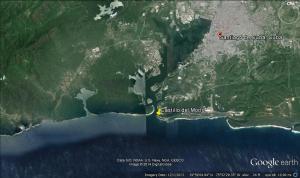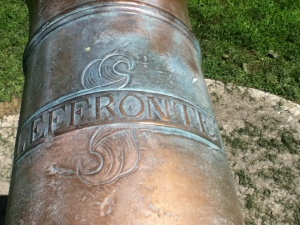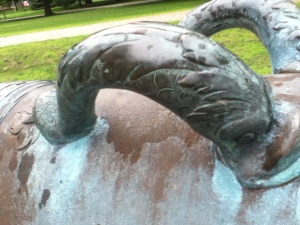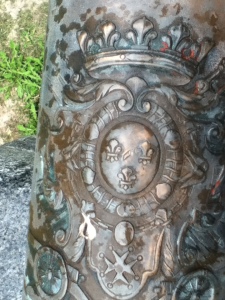L’Effronté was captured at Santiago de Cuba in southeastern Cuba during the Spanish-American War. After victory at the Battle of San Juan Hill—most famous for the actions of future president Theodore Roosevelt and his Rough Riders—the Americans besieged Santiago; the Spanish surrendered and evacuated by 17 July. On that very day, as the Americans occupied the city, the commanding general of the U.S. Army in Cuba, MG William R. Shafter, reported to the Adjutant-General of the U.S. Army, BG Henry C. Corbin, that he had captured 15 bronze cannons that he supposed were for ceremonial purposes; by 22 August, Shafter had shipped most of these guns back to the U.S.1 There was evidently quite a number of these old cannons around Santiago: George Kennan, a journalist embedded with the Americans, found two French guns in the Morro Castle, located on the eastern side of the entrance to Santiago’s port. Both guns were also made during the tenure of Louis-Charles de Bourbon, one in 1748 and the other in 1755.2 Of the Latin motto “ultima ratio regum” inscribed on them, Kennan wrote that “the recent discussions between Morro Castle and Admiral Sampson’s fleet proved conclusively that the ‘last argument of kings’ is much less cogent and convincing than the first argument of battle-ships.” L’Effronté was probably found at Castel del Morro.

Major General William R. Shafter, commanding general of the Fifth Army Corps during the Spanish-American War. His troops captured 18th century French cannons, including l’Effronté, and he ordered them sent to the U.S. as trophies.
An article from the Charlotte Observer on 5 October 1898 details the arrival in the U.S. of 10 French guns, including l’Effronté. These trophy cannons were distributed across the U.S. for display. L’Effronté was given to the Grand Army of the Republic post in Galesburg.3 The Grand Army of the Republic was an organization founded by Union Army soldiers in order to advocate on behalf of veterans. In February 1901, the cannon was unveiled in Central Park;4 later, it was moved to the courthouse grounds where it stands today and where I saw it earlier this summer.

A postcard of L’Effronté in Galesburg’s Central Park in the early 20th century. The cannon was later moved to the grounds of the county courthouse.
The mystery that remains is how l’Effronté and its brethren cannons got from France to Cuba. One idea was put forth by Charles Edward Lloyd, the author of the 5 October 1898 article in the Charlotte Observer that I discuss above. He believed that the French cannon in Cuba must have been captured by Spanish forces during the Peninsular War (1807-1814). It is also possible that there was a more peaceful transfer of the weapons to Spain and then onward to Spain’s colony of Cuba. As in France, Bourbon monarchs ruled Spain throughout the 1700s, and therefore these arms may have been given to Spain and then transferred to Cuba at sometime. However, that still leaves 157 years of history between the casting of the l’Effronté and its capture at Santiago unaccounted for.
1Correspondence Relating to the War with Spain, vol. 1 (1902): 158, 249.
2G. Kennan, Campaigning in Cuba (1899): 202-203.
3Annual Reports of the War Department for the Fiscal Year Ended June 30, 1901: Report of the Chief of Ordnance (1902): 81.
4C.R. Robinson, Galesburg, Illinois in Vintage Postcards (2000): 16.











